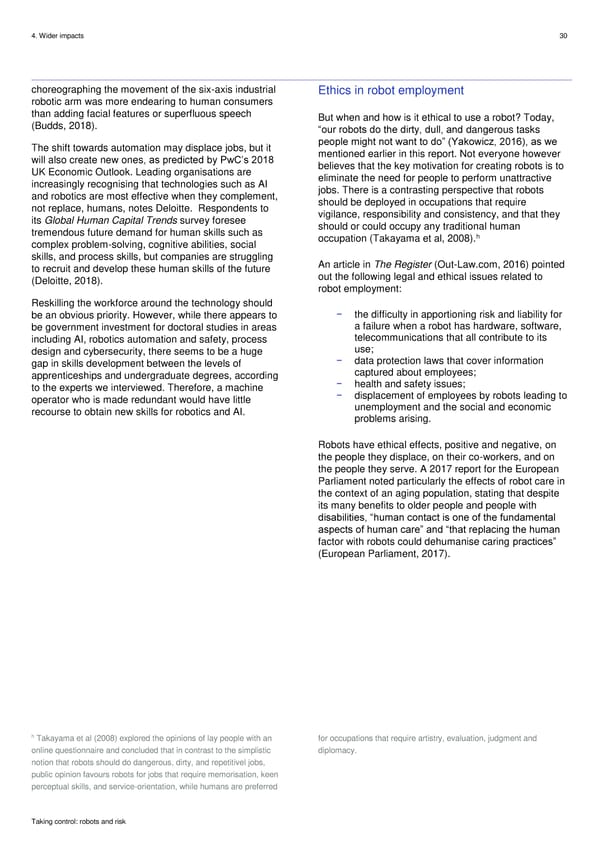4. Wider impacts 30 choreographing the movement of the six-axis industrial Ethics in robot employment robotic arm was more endearing to human consumers than adding facial features or superfluous speech But when and how is it ethical to use a robot? Today, (Budds, 2018). “our robots do the dirty, dull, and dangerous tasks The shift towards automation may displace jobs, but it people might not want to do” (Yakowicz, 2016), as we will also create new ones, as predicted by PwC’s 2018 mentioned earlier in this report. Not everyone however UK Economic Outlook. Leading organisations are believes that the key motivation for creating robots is to increasingly recognising that technologies such as AI eliminate the need for people to perform unattractive and robotics are most effective when they complement, jobs. There is a contrasting perspective that robots not replace, humans, notes Deloitte. Respondents to should be deployed in occupations that require its Global Human Capital Trends survey foresee vigilance, responsibility and consistency, and that they tremendous future demand for human skills such as should or could occupy any traditional human h complex problem-solving, cognitive abilities, social occupation (Takayama et al, 2008). skills, and process skills, but companies are struggling An article in The Register (Out-Law.com, 2016) pointed to recruit and develop these human skills of the future out the following legal and ethical issues related to (Deloitte, 2018). robot employment: Reskilling the workforce around the technology should be an obvious priority. However, while there appears to − the difficulty in apportioning risk and liability for be government investment for doctoral studies in areas a failure when a robot has hardware, software, including AI, robotics automation and safety, process telecommunications that all contribute to its design and cybersecurity, there seems to be a huge use; gap in skills development between the levels of − data protection laws that cover information apprenticeships and undergraduate degrees, according captured about employees; to the experts we interviewed. Therefore, a machine − health and safety issues; operator who is made redundant would have little − displacement of employees by robots leading to recourse to obtain new skills for robotics and AI. unemployment and the social and economic problems arising. Robots have ethical effects, positive and negative, on the people they displace, on their co-workers, and on the people they serve. A 2017 report for the European Parliament noted particularly the effects of robot care in the context of an aging population, stating that despite its many benefits to older people and people with disabilities, “human contact is one of the fundamental aspects of human care” and “that replacing the human factor with robots could dehumanise caring practices” (European Parliament, 2017). h Takayama et al (2008) explored the opinions of lay people with an for occupations that require artistry, evaluation, judgment and online questionnaire and concluded that in contrast to the simplistic diplomacy. notion that robots should do dangerous, dirty, and repetitivel jobs, public opinion favours robots for jobs that require memorisation, keen perceptual skills, and service-orientation, while humans are preferred Taking control: robots and risk
 Robots & Risk Page 29 Page 31
Robots & Risk Page 29 Page 31